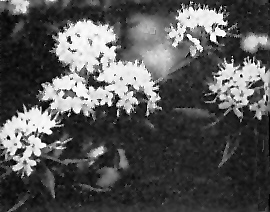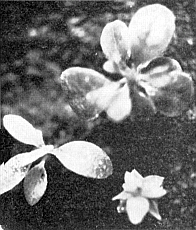QBARS - v28n4 Rhododendron x Ledum groenlandicum: A Promising Innovation
Rhododendron x Ledum groenlandicum:
A Promising Innovation
Donald W. Paden, Urbana, Illinois

|
|---|
FIG. 61. Excellent form of small white flowered trusses of Ledum groenlandicum and its hardiness are reasons it was chosen for an intergenetic breeding program. Photo by Donald Paden |

|
FIG. 62. Seedling of
Ledum groenlandicum
, lower right, is compared with seedlings from simultaneous plantings of
L. groenlandicum
x R. 'Elizabeth', left, and
L. groenlandicum
x
R. yakushimanum
, top right.
Photo by Donald Paden |
|---|
The article by K. Wada 1 reporting a number of unusual crosses involving rhododendrons prompts the present note on the crossing of R. sp and Ledum groenlandicum (Labrador Tea). Although these comments are somewhat premature, since the plants are still seedlings, it is hoped that the results will encourage others in similar ventures.
During the spring of 1973 six crosses were attempted with Ledum groenlandicum as the female parent plant. Of these, three produced viable seeds. One cross produced seedlings indistinguishable from a control batch of Ledum seedlings. The second produced only one plant, which is described below. The third was more prolific and these plants in their present state of development, are sharply differentiated from Ledum groenlandicum , as is the solitary seedling.
The single seedling was produced from pollen of R. 'Elizabeth'. This plant, bearing little or no resemblance to Ledum , seems to be the most vigorous of the lot. The credibility of its being a successful cross is heightened somewhat by an apparent related cross of Ledum glandulosum and R. 'Elizabeth', advertised in the Quarterly Bulletin some years ago. 2 The resulting "ledodendron" (originating with Leonard L. Brooks) was said to "set buds at an earlier age and more consistently" than most rhododendrons, tolerated a higher pH than other rhododendrons and was an acceptable landscape plant. Unfortunately, the seeds from the author's cross were sown at the same time as seeds from a dozen or more other crosses with R. yakushimanum , so there exists the possibility that the one plant is the result of a stray seed. However, the plant bears no close resemblance to the numerous other seedlings started at the same time.
The more prolific cross was made with pollen from R. yakushimanum 'Mist Maiden'. The seedlings from this cross are vigorous and again bear no resemblance to the Ledum seedlings grown from selfed seed collected at the same time. Indeed, the differences are striking. Within the lot of a dozen and a half plants, there is some variability with respect to size, structure and leaf shape, although none resembles precisely the numerous other crosses with R. yakushimanum . In the author's opinion, the very marked differences between the plants in question and the Ledum seedlings make for a highly probability of a successful cross. In assessing this likelihood, it is perhaps worth noting that Elmer E. Leppik traces the evolution of rhododendron rust to that on Ledum and Picea , observing that "all these host genera must have grown in close neighborhoods" at some time in the distant past. 3
For those who may be unfamiliar with Ledum groenlandicum , a few comments of interest. Labrador Tea is a native of the northern states, Canada and Greenland. The plant is a dwarf, upright shrub (2 to 3 feet tall), with narrow oblong, dark green leaves having a densely rusty tomentose undersurface. 4 The flowers are small, white and "showy," as contrasted to the spectacular flowers of most cultivated rhododendrons. The plant used in the present cross was collected in a bog in north central Minnesota and for at least the last ten or fifteen years has survived under conditions of benign neglect - situated by a clump of Pachistima canbyi and partly overgrown by English box. Because of the small size of the flowers, hand pollination is tedious in the extreme, at least as judged from the very limited experience of the author working with other rhododendrons.
The cross may be of more than passing interest to northern rhododendron growers, because of Ledum groenlandicum's extreme hardiness and its general tolerance of moist, bog-like grounds Temperature in Urbana, Illinois varies from -25° to 108°, with occasional steady winds which persist over extended periods of time in both winter and summer. In contrast with most rhododendrons, Ledum has flowered without fail in its present location and in spite of neglect.
Although it is fruitless to speculate concerning the mature characteristics of the plants which have been produced (assuming they survive adolescence), the possibility of crossing Ledum with various Rhododendron species offers new and exciting possibilities for imaginative and systematic plant breeding. Assuming suitable pollen can be obtained, additional crosses will be attempted in 1974, including replications of those described above. Whether these will be successful remains to be seen.
ACKNOWLEDGMENT
Appreciation is due Professor James Gerdemann, who collected and gave the ledum plant to the author, suggested the R. 'Elizabeth' cross, provided the pollen from R. 'Elizabeth' and made a number of suggestions incorporated in the present note.
REFERENCES
1.Wada, K., Hybridizing Myths of Evergreen Azaleas,
Quarterly Bulletin
, American Rhododendron Society, 28:101-105, 1974.
2. Ledum glandulosum x R. Elizabeth,
Quarterly Bulletin
, American Rhododendron Society, 16:272, 1965.
3. Leppik, Elmer E., Evolutionary Interactions between Rhododendrons, Pollinating Insects and Rust Fungi,
Quarterly Bulletin
, American Rhododendron Society, 28:70-89, 1974.
4. Robinson, Florence Bell,
Useful Plants and Shrubs
, 1960.

